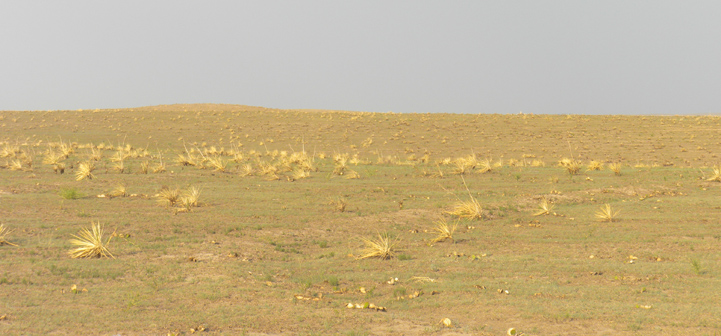
Landowners often are unable to carry out their fire program due to periodic droughts. Drought does present several challenges to using prescribed fire such as: lack of fuels, dangerous conditions, and burn bans. However, even during droughts, conditions safe to burn are often present. Further, droughts present some opportunities to meet certain objectives such as reduction of overstory fuels and creating a patchy burn.
Concerns
One of the primary limiting factors of a drought relative to fire is the lack of fine fuels. Lack of precipitation can lead to a reduction in grass growth in grasslands and leaf production in hardwood forests. These fine fuels are needed to carry fires. Therefore, fires many be patchy in nature or not carry across the burn unit at all. Another issue is that droughts are often accompanied by high temperatures and wind speeds which make conducting prescribed fire unsafe. Even when conditions may be safe, burn bans may remain in place for long periods of time during droughts due to perceived risk by policy makers. Droughts can place stress on plants and animals, and therefore many landowners are concerned about carrying out a fire that may negatively impact these already stressed plants and animals. The lack of rain following a fire is also a concern as grass and other plants may not respond and allow for extended periods of lack of cover, forage, and erosion potential.
Opportunities
The concerns listed above can also be viewed as opportunities. For instance, patchy burns are sometimes the desired outcome. This is especially true for wildlife management. If only 50% of the burn unit is consumed by fire, this may be exactly what the prescription called for. If the manager is attempting to remove overstory forest cover, burning during dry conditions when trees are stressed may be the perfect time to accomplish the objective (assuming you can safely carry out the fire).
Considerations
Always ensure that the fire is carried out under safe conditions that you have a reasonable chance of containing the fire. While burning during extreme conditions may yield desirable outcomes, safety is the first priority. Ensure there is adequate personnel and equipment for the conditions and that the burns are legal at all times.
As weather is always an unknown, it is advisable to hedge and only burn portions of the landscape during droughts. This will ensure that some cover, forage, etc will remain until favorable weather returns.
Soil erosion is often a concern after a fire during drought as there is little ground cover. Much of this concern is unfounded as root biomass has tremendous soil stability potential. However, on steep slopes and in certain soil textures, extra considerations may be warranted.
A final consideration is that fire frequency is the most important consideration regarding fire effects. Thus, you should do everything possible to maintain the appropriate fire frequency to meet your objectives. This will often mean burning under conditions that are not perfect. At times when fire is not possible, remember that you will need to burn those units as soon as conditions allow to stay as close to the appropriate fire return interval as feasible.
